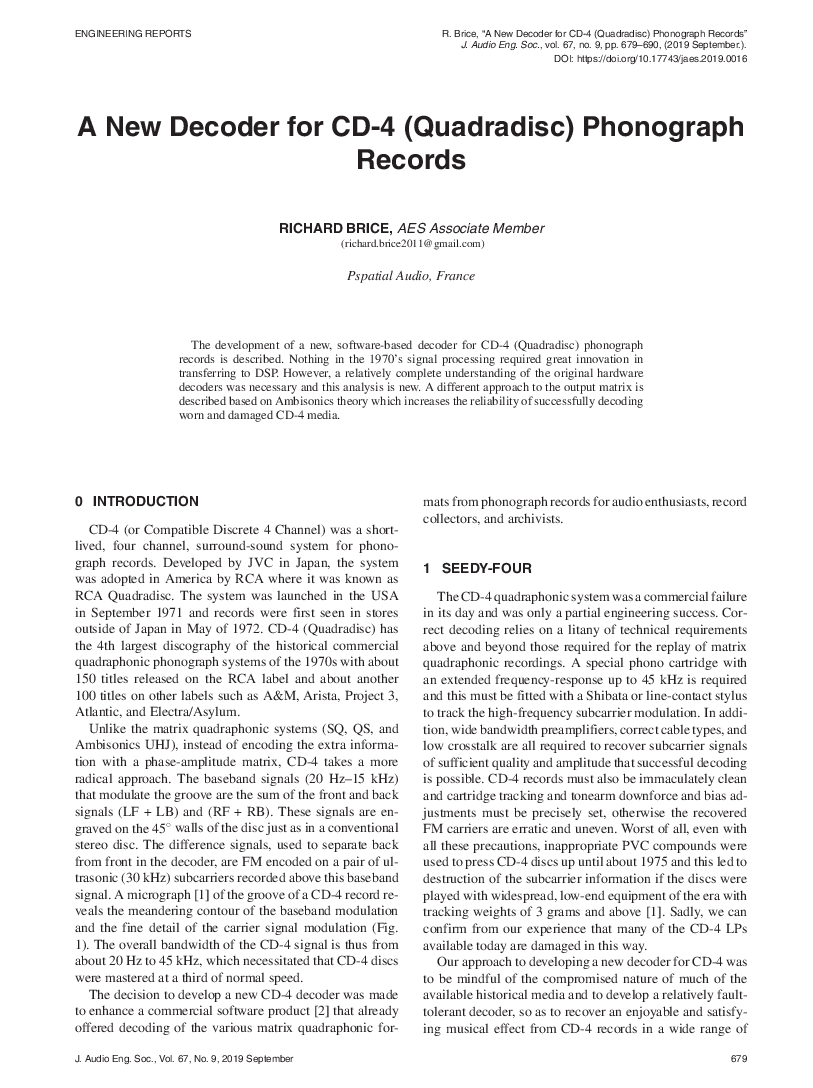Home / Publications / E-library page
You are currently logged in as an
Institutional Subscriber.
If you would like to logout,
please click on the button below.
Home / Publications / E-library page
Only AES members and Institutional Journal Subscribers can download
CD-4 (or Compatible Discrete 4 Channel) was a short-lived, four-channel, surround-sound system for phonograph records. Developed by JVC in Japan, the system was adopted in America around 1972 by RCA where it was known as RCA Quadradisc. Unlike matrix quadraphonic systems, CD-4 took a more radical approach. The baseband signals, which modulate the groove, are the sum of the front and back signals (LF + LB) and (RF + RB). The difference signals, used to separate back from front in the decoder, are FM encoded on a pair of ultrasonic (30kHz) subcarriers recorded above this baseband signal. The development of a new, software-based decoder for CD-4 phonograph records is described in this report. A relatively complete understanding of the original hardware decoders is necessary, and this analysis is new. A special phono cartridge with an extended frequency-response up to 45 kHz is required, and this must be fitted with a Shibata or line-contact stylus to track the high-frequency subcarrier modulation. In addition, wide bandwidth preamplifiers, correct cable types, and low crosstalk are all required to recover subcarrier signals of sufficient quality and amplitude so that successful decoding is possible. A different approach to the output matrix is described based on Ambisonics theory, which increases the reliability of successfully decoding worn and damaged CD-4 media.
Author (s): Brice, Richard
Affiliation:
Pspatial Audio, France
(See document for exact affiliation information.)
Publication Date:
2019-09-06
Import into BibTeX
Permalink: https://aes2.org/publications/elibrary-page/?id=20544
(612KB)
Click to purchase paper as a non-member or login as an AES member. If your company or school subscribes to the E-Library then switch to the institutional version. If you are not an AES member Join the AES. If you need to check your member status, login to the Member Portal.

Brice, Richard; 2019; A New Decoder for CD-4 (Quadradisc) Phonograph Records [PDF]; Pspatial Audio, France; Paper ; Available from: https://aes2.org/publications/elibrary-page/?id=20544
Brice, Richard; A New Decoder for CD-4 (Quadradisc) Phonograph Records [PDF]; Pspatial Audio, France; Paper ; 2019 Available: https://aes2.org/publications/elibrary-page/?id=20544